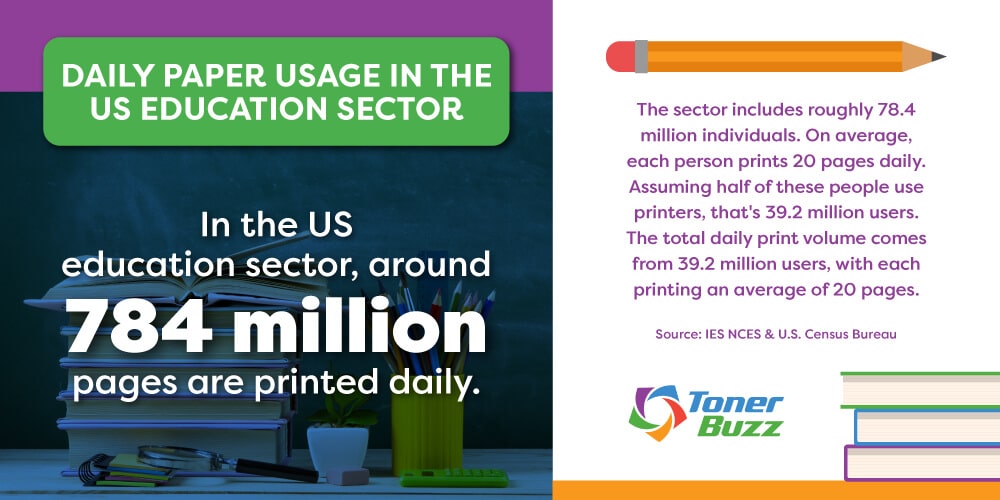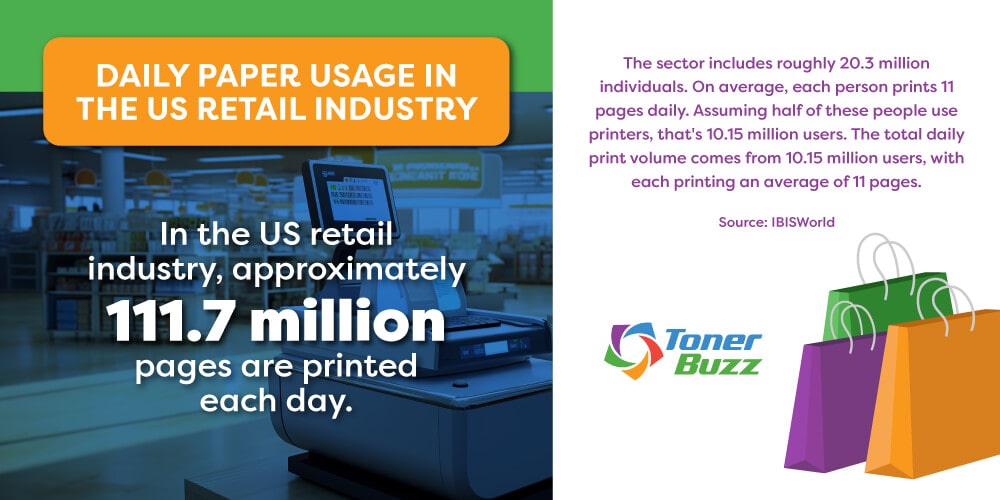Which Industries Print the Most?
Posted by Rob Errera on 04/25/2024

✅ Quick Answer:
The following are the six most printed industries in 2024:
#1. Education: 784 million pages per day
#2. Medical: 271.95 million pages per day
#3. Retail: 111.7 million pages per day
#4. Finance: 79.8 million pages per day
#5. Manufacturing: 79.4 million pages per day
#6. Law: 48.19 million pages per day
Methodology
It's well understood that printing is a routine activity in many workplaces, but identifying the industries that print the most is not straightforward.
At Toner Buzz, we've embarked on an analysis to determine the top printing industries.
Our methodology relies on two key data points: the average number of pages printed per person per day in various industries and the total employment figures for these industries.
Given that the most recent data on average daily print volume per user dates back to 2016, and recognizing that workplace practices have likely evolved towards more digital solutions, we are using this historical data as a baseline for our estimates.
To adapt our model to reflect current trends, where digital workflows may have reduced traditional printing needs, we are adjusting our calculations by assuming only half of the reported employees in each sector still engage in regular printing activities. Therefore, our adjusted formula to estimate total daily pages printed in each industry is:
Adjusted total daily pages printed = (average daily print per user) × (number of employees ÷ 2)
This conservative approach allows us to account for the increasing shift towards digital documentation, providing a more current perspective on printing habits across different sectors.
Daily Printing by Industry 2024 (US)
| Industry |
Average daily pages printed |
Average daily pages printed per user |
Total number of users |
Half of users |
| Education | 784 million | 20 | 78.4 million | 39.2 million |
| Medical | 271.95 million | 37 | 14.7 million | 7.35 million |
| Retail | 111.7 million | 11 | 20.3 million | 11.15 million |
| Finance | 79.8 million | 21 | 7.6 million | 3.8 million |
| Manufacturing | 79.4 million | 14 | 11.3 million | 5.6 million |
| Law | 48.19 million | 79 | 1.22 million | 610,000 |
Now let's take a closer look at each industry separately.
Education

In our list, the Education Sector ranks first as the top user of paper for printing. With about 3.2 million teachers and 75.2 million students in US schools, totaling 78.4 million people, we can estimate that half of them use printing services in schools.
To calculate the total number of pages printed per day, we multiply the number of users who print by the average number of pages printed per user per day.
Given 39,2 million users who print and an average of 20 pages printed per user per day, the total pages printed per day would be 784 million pages.

Statistics from Different Years
2009
According to The Reflective Educator, a typical school in the US in 2009 went through about 2000 sheets (4000 pages) of paper daily. Since schools in the US operate for around 180 days, an average school used a total of 360,000 sheets (720,000 pages) of paper in a year.
There were approximately 132,000 schools in the United States meaning over 47.5 billion sheets of paper were used by educators that year.
Divide that by a 180 day school year and that leaves a mindboggling 264 million sheets or 528 million pages per day being used in our nation’s schools back in 2009.
2017-2018
During our research we also discovered that some universities have actually shared their printing data.
In 2018, even during the summer holidays, Swarthmore College reported printing around 60,000 pages, averaging 667 pages per day. However, this number dramatically increased during the semester.
In just the first month of the first semester, they printed nearly 444,233 pages, averaging 16,453 pages daily, with peaks up to 25,000 pages at the start of classes.
This shows a much higher daily average during the academic semester compared to the summer.
In 2017 and 2018, Swarthmore College printed a lot of pages. In the fall of 2017, they printed 1,259,649 pages, and in the spring of 2018, they printed 1,545,613 pages. During the summer of 2018, they still printed 60,000 pages.
To figure out the total for the whole school year, we added up all these numbers. The fall and spring semesters together totaled 2,805,262 pages, and with the summer added, the total for the year was 2,865,262 pages.
Calculating over 180 academic days, the average was about 15,918 pages daily. Including summer, over 220 days, the average was about 13,024 pages daily.
2019
In contrast, the University of North Georgia reported an annual print volume of 4.2 million pages in 2019, with an average of 23,333 pages per day during the academic year.
Medical

The Medical Industry ranks as the second highest in terms of printing, following the education sector.
In the U.S., about 9.3% of all jobs are in healthcare, with 14.7 million people working in this sector.
Typically, a person in healthcare prints 37 pages a day. If we estimate that only half of these individuals, or 7.35 million people print documents daily, then the medical industry ends up printing around 271.95 million pages every day.
Also, hospitals use a lot of paper. According to a 2018 report, a big hospital with 1,500 beds can use over 8 million pages a month.
That's about 178 pages for each bed every day.
If a medical office worker typically prints 37 pages daily, this results in the medical sector generating an average of 214 pages of patient paperwork per day.
Using the estimate of 178 pages per hospital bed per day, and considering a 1,500-bed hospital prints about 267,000 pages daily.
With 916,752 hospital beds in the US and an average of 178 printed pages per bed per day, the total comes to approximately 163 million pages printed daily across all hospitals in the US.
Retail

In the Retail industry, each user prints an average of 11 pages per day.
Although the industry is ranked sixth in the table for average daily printing per user, the number of employees in this sector is increasing.
As of 2023, there are 20,325,461 people employed in the Retail Trade industry in the US. Considering only half of these employees and accounting for the average printing per user, the total daily number of pages printed in the Retail Trade industry is 111,7 million pages.
This ranks it third on our list.

Finance

The Finance Industry ranks as the fourth highest in terms of printing, following the retail sector.
With approximately 7.6 million people working in the Finance & Insurance Industry, and each financial professional printing around 21 pages daily, we estimate that about half of these employees actively use printers.
This leads to a total of 79.8 million pages being printed each day in the finance sector.
According to BizTech, many firms within the finance sector do not expect their paper usage to decrease in the coming years, indicating a continued reliance on printed documents for their operations.
Check also: Printing Industry Trends: What Do Stats Tell Us?
Manufacturing

As of 2023, there are approximately 11,357,140 people employed in the Manufacturing industry in the US.
On average, each user in the manufacturing industry prints about 14 pages a day.
Despite the seemingly low number, when calculating the total, it surpasses the volume of printing in the Law industry, which is also significant in paper consumption.
As a result, considering half of the employees in the Manufacturing industry, which would be approximately 5,678,570 people, and each of them printing an average of 14 pages a day, the total number of pages printed per day in the Manufacturing industry would be 79.4 million.
Law

Employees in the legal industry have been identified as the highest users of printed pages in the report, with an average of 79 pages per user per day.
With an estimated 1.22 million legal employees in the United States, and assuming half of them are actively using printing services, the industry collectively prints an estimated total of around 48,190,000 pages each day.
In 2006, a study by the Arnold & Porter firm in Washington, D.C., showed that a typical lawyer uses between 20,000 and 100,000 sheets of copy paper each year.
Assuming a forty-hour workweek, that averages to 30 pages per hour or a whopping 240 pages per day! Looking at it monthly, it's roughly 5,000 pages per month.
When comparing the two periods, it's evident that the legal industry printed significantly more in 2006 than it does now.
Despite this decline, the law industry continues to rank among the top sectors in terms of printing volume.
Which Industries Spend the Most on Printing?
According to Printing Impressions, the 10 industries expected to spend the most printed materials are:
- Packaged foods ($19.9 billion) - everything you purchase comes in a printed package.
- Medical and Pharmaceutical ($18.8 billion) - from billing to brochures the medical and pharmaceutical industries do a lot of printing!
- Publishing ($12.4 billion) - books, periodicals, and more!
- Health providers ($11.7 billion) - helping printing investments in marketing materials and print advertising.
- Travel and Hospitality ($11.1 billion) - plenty of printed materials here!
- Real estate ($10.9 billion) - despite the rise of real estate apps, print is still a powerful tool in the advertising business.
- Beverages ($10.7billion) - packaging, labels, and advertising.
- Banking/Insurance ($10.5 billion) - all those annual reports!
- Telecommunications ($10.2 billion) - wireless providers invest heavily in print.
- Foodservice ($9 billion) - blitz advertising, updated menus, and a plethora of printing.
Furthermore, the overall U.S. printing industry has shown significant growth, valued at $87.7 billion in 2023, up from $77.7 billion in 2021. This increase highlights the industry's resilience and continued relevance despite the digital transition in many sectors.
Takeaways
In conclusion, our analysis reveals that the leading sectors in daily printing volumes—Education, Medical, and Retail—are not just high due to the amount of printing they do, but also because of the large number of users involved in these industries.
Education tops the list with its massive user base and significant daily print needs, emphasizing the sector's dependency on paper-based resources.
Similarly, the Medical and Retail sectors show considerable printing activities, driven by both their operational demands and the extensive numbers of personnel who rely on printed materials.
This study highlights the critical role of printing in these key industries and underscores the need for ongoing evaluation of printing practices as digital alternatives continue to evolve.
- https://web.archive.org/web/20191011160904/https:/...
- https://nces.ed.gov/fastfacts/display.asp?id=372#P...
- https://www.census.gov/newsroom/press-releases/202...
- https://davidwees.com/content/paper-use-schools/
- https://nces.ed.gov/fastfacts/display.asp?id=84
- https://blogs.swarthmore.edu/its/2018/09/27/how-mu...
- https://ung.edu/information-technology/managed-pri...
- https://www.bls.gov/spotlight/2023/healthcare-occu...
- https://www.healthcarefinancenews.com/news/hospita...
- https://www.statista.com/statistics/185860/number-...
- https://www.ibisworld.com/industry-statistics/empl...
- https://www.ibisworld.com/industry-statistics/empl...
- https://www.ibisworld.com/industry-statistics/empl...
- https://www.ibisworld.com/united-states/market-res...
- https://www.statista.com/statistics/318757/number-...
- https://www.abajournal.com/news/article/one_paper_...
- https://web.archive.org/web/20220626051009/https:/...
 Calculating arrival date
Calculating arrival date









